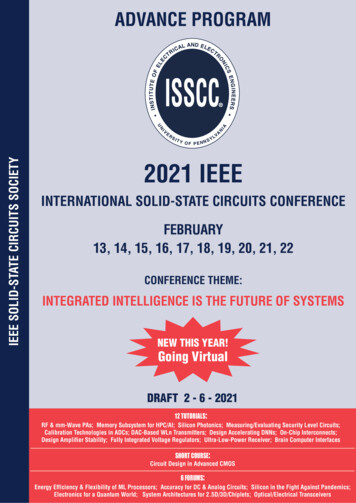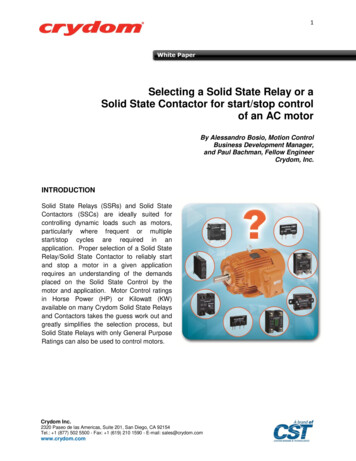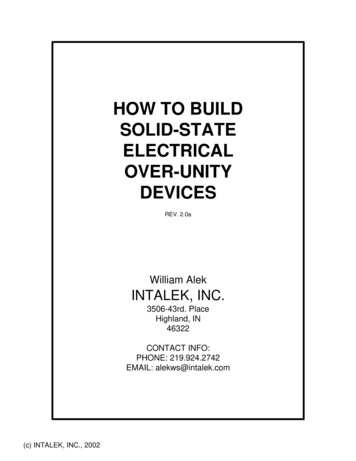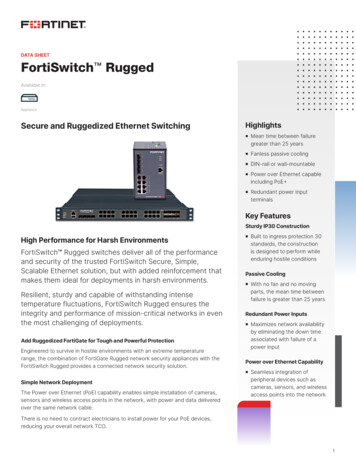
Transcription
IEEE SOLID-STATE CIRCUITS SOCIETYADVANCE PROGRAM2021 IEEEINTERNATIONAL SOLID-STATE CIRCUITS CONFERENCEFEBRUARY13, 14, 15, 16, 17, 18, 19, 20, 21, 22CONFERENCE THEME:INTEGRATED INTELLIGENCE IS THE FUTURE OF SYSTEMSNEW THIS YEAR!Going VirtualDRAFT 2 - 6 - 202112 TUTORIALS:RF & mm-Wave PAs; Memory Subsystem for HPC/AI; Silicon Photonics; Measuring/Evaluating Security Level Circuits;Calibration Technologies in ADCs; DAC-Based WLn Transmitters; Design Accelerating DNNs; On-Chip Interconnects;Design Amplifier Stability; Fully Integrated Voltage Regulators; Ultra-Low-Power Receiver; Brain Computer InterfacesSHORT COURSE:Circuit Design in Advanced CMOS6 FORUMS:Energy Efficiency & Flexibility of ML Processors; Accuracy for DC & Analog Circuits; Silicon in the Fight Against Pandemics;Electronics for a Quantum World; System Architectures for 2.5D/3D/Chiplets; Optical/Electrical Transceivers
CONFERENCE TECHNICAL HIGHLIGHTSISSCC VISION STATEMENTThe International Solid-State Circuits Conference is the foremost global forum for presentation ofadvances in solid-state circuits and systems-on-a-chip. The Conference offers a unique opportunity forengineers working at the cutting edge of IC design and application to maintain technical currency, andto network with leading experts.ISSCC 2021 ON-DEMAND CONTENT / RELEASE ! Recorded content available until March 31, 2021CONFERENCE TECHNICAL HIGHLIGHTSThis year, ISSCC 2021 will be available only virtually.See next page for Conference schedule details.2
ISSCC 2021 CONFERENCE SCHEDULEISSCC 2021 LIVE SESSIONS ALL TIMES ARE PACIFIC STANDARD TIMEEDUCATIONISSCC 2021 SATURDAY, FEBRUARY 13TH 7:00 am – T1:Fundamentals of RF and mm-Wave Power-Amplifier Designs7:20 am – T2:Fundamentals of Memory Subsystem Design for HPC and AI8:00 am – T4:Measuring and Evaluating the Security Level of CircuitsTUTORIALS7:40 am – T3:Silicon Photonics – from Basics to ASICs8:40 am – T6:Basics of DAC-Based Wireline Transmitters8:20 am – T5:Calibration Techniques in ADCs7:40 am – T9:Designing Amplifiers for Stability7:20 am – T8: On-Chip Interconnects:Basic Concepts, Designs, & Future Opportunities7:00 am – T7:Basic Design Approaches to Accelerating Deep Neural Networks8:00 am – T10:Fundamentals of Fully Integrated Voltage Regulators8:20 am – T11:Ultra-Low-Power Wireless-Receiver DesignISSCC 2021 SUNDAY, FEBRUARY 14TH8:40 am – T12: Brain Computer Interfaces:Fundamentals to Future Technologies SHORT COURSE7:05 am – SC1:Introduction to PLLs: Phase Noise, Modeling, and Key Wireless Design Considerations7:35 am – SC2:PLL Architectures, Tradeoffs, and Key Application Considerations8:05 am – SC3:Clocking, Clock Distribution, and Clock Management in Wireline/Wireless Subsystems8:35 am – SC4:Processor Clock Generation, Distribution, and Clock Sensor/Management LoopsINNOVATIONSISSCC 2021 MONDAY, FEBRUARY 15TH6:30 - 7:00 AM ISSCC 2021 WELCOME REMARKS7:00 am7:45 amPlenary Paper 1.1:Plenary Paper 1.2:Unleashing the Future of InnovationAdaptive Intelligence in the New Computing Era8:30 am8:30 am9:30 amInvited Session 2:Invited Session 3:Mentoring SessionHighlighted Chip Releases: Modern Digital SoCsHighlighted Chip Releases: 5G and Radar Systems(Open to all)ISSCC 2021 TUESDAY, FEBRUARY 16TH7:00 am7:45 amPlenary Paper 1.3:Plenary Paper 1.4:Working at the Intersection of Machine Learning, Signal Processing, Sensors, and Circuits8:30 am8:30 amSession 4:Session 5:ProcessorsThere’s More to the Picture Than Meets the Eye (and in the future it will become only much more)8:30 am8:30 am8:30 amSession 6:Session 7:High-Performance Receivers andTransmitters for Sub-6GHz RadiosAnalog InterfacesSession 8:Ultra-High-Speed WirelineImagers and Range SensorsBreak Demo Videos Author Interviews9:30 - 10:30 am - Book DisplayISSCC 2021 WEDNESDAY, FEBRUARY 17TH7:00 am7:00amSession 9:Session 10:ML Processors From Cloud to Edge7:00amContinuous-Time ADCs and DACs7:00am7:00 am - Session 12:Session 11:Innovations in Low-Power and Secure IoTSession 14:Advanced Wireline Linksand TechniquesCryo-CMOS for Quantum Computing7:45 am - Session 13:mm-Wave Transceivers forCommunication and RadarBreak Demo Videos Author Interviews8:30 am - Session 15:8:30 amCompute-in-Memory Processors for DeepNeural NetworksSession 17:9:15 am - Session 16:DC-DC ConvertersComputation in MemoryBiomedical Devices, Circuits, and Systems8:30 am - Session 18:8:30 am - Session 20:High-Performance VCOsTerahertz for Communication and Sensing9:15 am - Session 19:9:15 am - Session 21:9:15 am - Session 23:Optical Systems for Emerging Applications8:30 am - Session 22:UWB Systems and Wake-Up ReceiversTHz Circuits and Front-EndsBreak Demo Videos Author Interviews9:30 - 10:30 am - Book DisplayISSCC 2021 THURSDAY, FEBRUARY 18TH7:00 am7:00 am - Session 24:Advanced Embedded MemoriesSession 26:7:45 am - Session 25:DRAMRF Power-Amplifier and Front-EndTechniques7:00 am7:00 amSession 27:Session 28:Discrete-Time ADCsBiomedical Systems7:00 amSession 29:Digital Circuits for Computing,Clocking and Power ManagementBreak Demo Videos Author Interviews8:30 am - Session 30:Non-Volatile Memory9:15 am - Session 31:Analog Techniques8:30 amSession 32:Frequency Synthesizers8:30 am8:30 am - Session 35:8:30 amSession 33:High-Voltage, GaN and WirelessPowerAdaptive Digital Techniques for VariationTolerant SystemsSession 34:9:15 am - Session 36:Emerging Imaging SolutionsHardware SecurityBreak Demo Videos Author Interviews9:30 - 10:30 am - Book DisplayISSCC 2021 FRIDAY, FEBRUARY 19TH SPECIAL EVENTS & DEMOS7:00 am – Special Event:What Technologies Will Shapethe Future of Computing?7:00 am – Special Event:Going Remote: Challenges and Opportunitiesto Remote Learning, Work, and Collaboration8:15 am – Special Event:Favorite Circuit Design and Testing Mistakesof Starting Engineers8:15 am - Special Event:ICs in PandemICsISSCC 2021 SATURDAY, FEBRUARY 20TH 7:00 amDemo Session 18:15 amDemo Session 2SPECIAL EVENTS8:15 am – Special Event:Student Research Preview7:00 am – Special Event:Making a Career ChoiceEXPLORATIONISSCC 2021 SUNDAY, FEBRUARY 21ST 7:00 am - F1:Striking the Balance Between Energy Efficiency & Flexibility:General-Purpose vs Special-Purpose ML Processors7:00 am - F2:Pushing the Frontiers in Accuracyfor Data Converters and Analog CircuitsISSCC 2021 MONDAY, FEBRUARY 22ND 7:00 am - F4:Electronics for a Quantum World7:00 am - F5:Enabling New System Architectureswith 2.5D, 3D, and ChipletsTimetableFORUMS7:00 am - F3:Silicon Technologies in the Fight Against Pandemics –from Point of Care to Computational EpidemiologyFORUMS7:00 am - F6:Optical and Electrical Transceivers for 400GbE and Beyond
TABLE OF CONTENTSSPECIAL EVENTSTUTORIALSTUTORIALS 1-12.4-9SE1What Technologies Will Shape the.50Future of Computing?SHORT COURSESE2Going Remote: Challenges and Opportunities.50to Remote Learning, Work, and CollaborationSCPLLs, Clocking, and Clock Distribution.10-12DEMO SESSIONSPAPER SESSIONS1Plenary Session 1.132Highlighted Chip Releases: 5G and Radar Systems.143Highlighted Chip Releases: Modern Digital SoCs.15DS1DEMO Session 1.51DS2DEMO Session 2.52SPECIAL EVENTSMENTORING SESSIONSE3Favorite Circuit Design and Testing.53Mistakes of Starting EngineersSE4ICs in PandemICs.53SE5Making a Career Choice.55SE6Student Research Preview (SRP).56SSCS Women in Circuits & Young Professionals.15PAPER SESSIONS1Plenary Session 2.164Processors.175Analog Interfaces.186High-Performance Receivers and.19Transmitters for Sub-6GHz Radios7Imagers and Range Sensors.208Ultra-High-Speed Wireline.219ML Processors From Cloud to Edge.2210Continuous-Time ADCs and DACs.2311Advanced Wireline Links and Techniques.2412Innovations in Low-Power and Secure IoT.2513Cryo-CMOS for Quantum Computing.2614mm-Wave Transceivers for Communication and Radar.2715Compute-in-Memory Processors.28for Deep Neural Networks16Computation in Memory.2917DC-DC Converters.30EXECUTIVE COMMITTEE.6318Biomedical Devices, Circuits, and Systems.31INTERNATIONAL TECHNICAL PROGRAM COMMITTEE.64-7019Optical Systems for Emerging Applications.32ITPC EUROPEAN SUBCOMMITTEE.7120High-Performance VCOs.33ITPC FAR EAST SUBCOMMITTEE.72-7321UWB Systems and Wake-Up Receivers.34CONFERENCE INFORMATION.7422Terahertz for Communication and Sensing.3523THz Circuits and Front-Ends.3624Advanced Embedded Memories.3725DRAM.3826RF Power-Amplifier and Front-End Techniques.3927Discrete-Time ADCs.4028Biomedical Systems.4129Digital Circuits for Computing,.42Clocking and Power Management30Non-Volatile Memory.4331Analog Techniques.4432Frequency Synthesizers.4533High-Voltage, GaN and Wireless Power.4634Emerging Imaging Solutions.4735Adaptive Digital Techniques for.48Variation Tolerant Systems36Hardware Security.49FORUMS3F1Striking the Balance Between Energy Efficiency.57& Flexibility: General-Purpose vs Special-PurposeML ProcessorsF2Pushing the Frontiers in Accuracy for.58Data Converters and Analog CircuitsF3Silicon Technologies in the Fight Against Pandemics.59– from Point of Care to Computational EpidemiologyF4Electronics for a Quantum World.60F5Enabling New System Architectures.61with 2.5D, 3D, and ChipletsF6Optical and Electrical Transceivers for.62400GbE and Beyond
Saturday, February 13thTUTORIALSTutorialsThere are a total of 12 tutorials this year on 12 different topics. Each tutorial, selected through a competitive process within eachsubcommittee of the ISSCC, presents the basic concepts and working principles of a single topic. These tutorials are intended for nonexperts, graduate students and practicing engineers who wish to explore and understand a new topic.Ali SheikholeslamiISSCC Education ChairThe presentations and the videos of all 12 tutorials (90 minutes each)will be available online, on-demand, as of:Friday, Feb. 5, 2021, 5:00pm, PSTuntil March 31, 2021.Live Q&A sessions for the tutorials will be available on:Feb. 13, 2021, 7:00am - 9:00am PST20 minute live session 5 minute summary 10 minute Q&A 5 minute breakThe Q&A sessions will be recorded and made available after their live sessions.Live Q&A - February 13, 7:00am PSTT1: Fundamentals of RF and mm-Wave Power-Amplifier DesignsHua Wang, Georgia Institute of Technology, Atlanta, GAThis tutorial presents an overview of RF and mm-wave power-amplifier (PA) designs in silicon, focusing on the design fundamentals. First,the tutorial introduces PA performance metrics and their impact on wireless systems. Next, it presents the design basics of both PA activecircuits and passive networks. The tutorial discusses popular PA classes, such as Class A, AB, B/C, E, F/F-1, and J. Finally, the tutorialconcludes with several RF and mm-wave PA design examples.Hua Wang is an associate professor at the School of Electrical and Computer Engineering at the Georgia Insitute of Technology and thedirector of the Georgia Tech Electronics and Micro-System (GEMS) lab. Prior to that, he worked at Intel Corporation and Skyworks Solutions.He received his M.S. and Ph.D. degrees in electrical engineering from the California Institute of Technology, Pasadena, in 2007 and 2009,respectively.Dr. Wang is interested in innovative analog, mixed-signal, RF, and mm-wave integrated circuits and hybrid systems for wirelesscommunication, sensing, and bioelectronics applications. He has authored or co-authored over 170 peer-reviewed journal and conferencepapers.Dr. Wang received the DARPA Director’s Fellowship Award in 2020, the DARPA Young Faculty Award in 2018, the NSF CAREER Award in2015, the Qualcomm Faculty Award 2020, and the IEEE MTT-S Outstanding Young Engineer Award in 2017. His GEMS research group haswon multiple academic awards and best paper awards, including the 2019 Marconi Society Paul Baran Young Scholar, the IEEE RFIC BestStudent Paper Awards (2014, 2016, and 2018), the IEEE CICC Outstanding Student Paper Awards (2015, 2018, and 2019), the IEEE CICCBest Conference Paper Award (2017).4
Saturday, February 13thTUTORIALSLive Q&A - February 13, 7:20am PSTT2: Fundamentals of Memory Subsystem Design for HPC and AIKyu-Hyoun (KH) Kim, IBM T. J. Watson, Yorktown Heights, NYThis tutorial will help the audience understand memory subsystem design choices for various applications and systems: includingtechnology, hierarchy, architecture, interface and packaging. The talk will begin with an overview of basics of memory subsystems includingmemory interfaces (device and module interfaces), controllers, subsystem architectures and RAS & ECC. The tutorial will then move on toexplore memory subsystem design optimizations for HPC and AI applications.Kyu-Hyoun (KH) Kim received his Ph.D. degree in EE from KAIST in 1997. In 1998, he joined Samsung Electronics and led the I/O circuitdesign team for DDR1/DDR2/DDR3 SDRAM and graphic memories.He joined IBM T. J. Watson in 2006, and led memory subsystem development for IBM’s HPC systems: including BlueGene and Exascalesystems. He is now in charge of exploratory AI hardware.He represents IBM in JEDEC for memory standardization. He received the JEDEC Technical Recognition Award in 2011 and an Award ofExcellence in 2019.Dr. Kim has presented eight papers at the International Solid-State Circuits Conference (ISSCC) as a first author between 1996 and 2009.He received the ISSCC Takuo Sugano Outstanding Paper Award in 2007. He holds 168 U.S. patents.Live Q&A - February 13, 7:40am PSTT3: Silicon Photonics – from Basics to ASICsSudip Shekhar, University of British Columbia, Vancouver, CanadaThe impact of silicon photonics is expected to grow exponentially in the next decade, driven by the demand for routing, switching, sensing,and computing massive amounts of data.In this tutorial, the basics of silicon photonic devices will be first presented briefly. Then state-of-the-art examples of silicon photonics andCMOS circuits will be described for high-speed intensity-modulation and coherent links, router-switches, biomedical sensing, and computeaccelerators.Sudip Shekhar received his B.Tech. degree from the Indian Institute of Technology, Kharagpur, and the Ph.D. degree from the University ofWashington, Seattle, in 2003 and 2008, respectively.From 2008 to 2013, he was with the Circuits Research Laboratory, Intel Corporation, Hillsboro, OR, USA, where he worked on high-speedI/O architectures. He is currently an Associate Professor of Electrical and Computer Engineering with the University of British Columbia.His research interests include circuits for high-speed electrical and optical I/O interfaces, frequency synthesizers, and wireless transceivers.Dr. Shekhar was a recipient of the IEEE Transactions on Circuit and Systems Darlington Best Paper Award in 2010 and a co-recipient of theIEEE Radio-Frequency IC Symposium Best Student Paper Award in 2015.5
Saturday, February 13thTUTORIALSLive Q&A - February 13, 8:00am PSTT4: Measuring and Evaluating the Security Level of CircuitsIngrid Verbauwhede, KU Leuven, Leuven, BelgiumWhen we design for low power, we estimate the power consumption at design time and measure it after fabrication and before we submitit to ISSCC. The same must be done with the security evaluation of a circuit: it should be estimated at design time, and measured afterfabrication. It is however difficult to measure security. Therefore, in this tutorial, we plan to show how to perform the security evaluationfor different classes of circuits: true random number generators, physically unclonable functions and side-channel evaluation ofcryptographic implementations.When designing a true random number generator, statistical tests on the output data are not sufficient: important in this context are theNIST standards SP800-90B and the German BSI AIS20/31 standards to evaluate true randomness. In the context of physically unclonablefunctions, established standards do not exist yet: here it is important to evaluate how much is the total cost to generate a full-entropy key.When evaluating the resistance to side-channel and fault attacks, it is important to describe the set-up of the experiments. If not, the onlyconclusion one can make is that the circuit resists an evaluation with the given set-up.Dr. Ir. Ingrid Verbauwhede is a Professor in the COSIC research group of the Electrical Engineering Department of the KU Leuven. She isalso adjunct professor at the University of California, Los Angeles. She received her PhD degree from the KU Leuven and was a postdoctoral researcher at UC Berkeley. At COSIC, she leads the secure embedded systems and hardware group. She is a Member of IACR anda Fellow of the IEEE. She was elected as member of the Royal Flemish Academy of Belgium for Science and the Arts in 2011. She is arecipient of an ERC Advanced Grant in 2016 and received the IEEE 2017 Computer Society Technical Achievement Award.She is a pioneer in the field of efficient and secure implementations of cryptographic algorithms on many different platforms: ASIC, FPGA,embedded, cloud. With her research she bridges the gaps between electronics, the mathematics of cryptography and the security of trustedcomputing, including physically unclonable functions and true random number generators. Her group owns and operates an advancedelectronic security evaluation lab. She is the author and co-author of more than 300 publications in conferences, journals, book chaptersand books.Live Q&A - February 13, 8:20am PSTT5: Calibration Techniques in ADCsAhmed Ali, Analog Devices, Greensboro, NCDigitally assisted ADCs have become mainstream. Fine geometry processes and the insatiable need for higher resolution ADCs at highersample rates have made sophisticated digital assistance a necessity. In this tutorial, we cover some of the advanced calibration techniquesfor high-speed and high-resolution ADCs. These include techniques to correct for inter-stage gain and settling errors, amplifier non-linearity,memory, DAC and reference errors. The tutorial will discuss the advantages and limitations of the different approaches, some of the practicalconsiderations, and some state-of-the-art examples.Ahmed M. A. Ali received the Ph.D. degree in electrical engineering from the University of Pennsylvania. He is a Fellow at Analog Devices,where he has led the design and development of several industry and world firsts in the high-speed data converter field. Before AnalogDevices, he was with Texas Instruments and an Adjunct Assistant Professor at the University of Pennsylvania. He is an Associate Editor ofthe IEEE Transactions on Circuits and Systems I and was an SSCS Distinguished Lecturer. He is the author of the book: “High Speed DataConverters”, by the Institution of Engineering & Technology (IET).6
Saturday, February 13thTUTORIALSLive Q&A - February 13, 8:40am PSTT6: Basics of DAC-Based Wireline TransmittersFriedel Gerfers, Technische Universität Berlin, Berlin, GermanyThis tutorial presents a practical overview of current-mode and voltage-mode DAC drivers, focusing on the fundamentals, accuracychallenges and design solutions.First, the tutorial explains transmitter specifications for swing, jitter, equalization and linearity, while also introducing DAC performancemetrics and discussing their overall impact on wireline systems.Next, the current-mode and voltage-mode DAC architectures are introduced while highlighting the pros and cons of each. High-speeddesign challenges, bandwidth and non-linearity trade-offs are reviewed. PVT and mismatch effects, swing enhancements and calibrationtechniques are introduced.The tutorial concludes with several DAC design examples utilizing deep submicron CMOS technologies reaching up to 56Gbaud/s.Friedel Gerfers is a full professor in the Computer Engineering and Microelectronics Department at the Technische Universität Berlin,Germany and holds the Einstein-Professorship for Mixed-Signal Circuit Design.He received the Dr.-Ing. degree from the Albert-Ludwigs-University Freiburg, Germany, in 2005.Thanks to his entrepreneurial spirit, he co-founded two the technology start-ups in 2009 and 2018: NiederRhein Technologies, in MountainView, USA and IC4X GmbH, in Berlin, Germany, which specialize in the development of high-performance analog and mixed-signal circuitsand systems.Prof. Gerfers is an author of the book “Continuous-Time Sigma-Delta A/D conversion, Fundamentals, Error Correction and RobustImplementations”.Live Q&A - February 13, 7:00am PSTT7: Basic Design Approaches to Accelerating Deep Neural NetworksRangharajan Venkatesan, NVIDIA, Sunnyvale, CADeep neural networks are used across a wide range of applications. Custom hardware optimizations for this field offer significantperformance and power advantages compared to general-purpose processors. However, achieving high TOPS/W and/or TOPS/mm2 alongwith the requirements for scalability and programmability is a challenging task.This tutorial presents various design approaches to strike the right balance between efficiency, scalability, and flexibility across differentneural networks and towards new models. It presents a survey of (i) different circuits and architecture techniques to design efficient computeunits, memory hierarchies, and interconnect topologies, (ii) compiler approaches to effectively tile computations, and (iii) neural networkoptimizations for efficient execution on the target hardware.Rangharajan Venkatesan is a Senior Research Scientist at NVIDIA. He received his B.Tech. degree in Electronics and CommunicationEngineering from the Indian Institute of Technology, Roorkee in 2009 and his Ph.D. degree in Electrical and Computer Engineering fromPurdue University in 2014. His research interests include machine learning accelerators, high-level synthesis, spintronic memories, andSoC design methodologies. Dr. Venkatesan’s paper on scalable deep-learning accelerator design received the Best Paper Award at theInternational Symposium on Microarchitecture (MICRO), 2019. His work on spintronic memory design was recognized with the Best PaperAward at the International Symposium on Low Power Electronics and Design (ISLPED), 2012 and a Best Paper nomination at the Design,Automation and Test Conference and Exhibition (DATE) in Europe, 2017. Dr. Venkatesan’s work on FinFET-based SRAM also received aBest paper nomination at the Design, Automation and Test Conference and Exhibition (DATE) in Europe, 2015. Dr. Venkatesan has been amember of the technical program committees of several leading IEEE conferences including the International Solid-State Circuits Conference(ISSCC), the International Symposium on Microarchitecture (MICRO), the Design Automation Conference (DAC), and the InternationalSymposium on Low Power Electronics and Design (ISLPED).7
Saturday, February 13thTUTORIALSLive Q&A - February 13, 7:20am PSTT8: On-Chip Interconnects: Basic Concepts, Designs, & Future OpportunitiesYvain Thonnart, CEA-List, Grenoble, FranceOn-chip communication impacts the performance, energy efficiency, and area of systems-on-chip, multi-processors and highly parallelaccelerators. This tutorial introduces a range of design options for on-chip interconnects. It presents routing schemes and mapping ofdifferent protocol families, flow-control and arbitration, synchronization strategies across clock domains, and fully asynchronous circuits.Finally, it introduces the potential of 3D-chip integration for on-chip communication.Yvain Thonnart graduated from the Ecole Polytechnique and received the MS degree in 2005 from Telecom ParisTech, France. In 2005, Hejoined the Technological Research Division of CEA, the French Alternative Energies and Atomic Energy Commission, within CEA-Leti until2019, then within CEA-List. He is now senior expert on communication & synchronization in systems-on-chip, and scientific advisor forthe mixed-signal lab. His main research interests include asynchronous logic, networks-on-chip, physical implementation, emergingtechnologies integration, and interposers. He has contributed to and led several digital circuits projects, and co-authored more than 60technical papers and 10 patents.Live Q&A - February 13, 7:40am PSTT9: Designing Amplifiers for StabilityViola Schaffer, Texas Instruments, Freising, GermanyMost amplifier designers spend at least as much or more effort assuring stability under all operating conditions with proper frequencycompensation than on other amplifier features. This tutorial will revisit the basics of frequency compensation such as Miller, parallel,nested-Miller and feed-forward compensation and compare them in terms of power efficiency and load-drive capabilities. We will look intothe loading effects of subsequent stages, common design traps and round up with a case study of recently published amplifiers.Viola Schäffer was born in Szeged, Hungary in 1974. She received the M.S. degree in electrical engineering from the University of Arizona,Tucson in 1999.She joined Texas Instruments Incorporated (formerly Burr-Brown Corporation) in 1998 and has been working as an analog IC designengineer/manager at various locations including Tucson, Arizona, as well as Erlangen and Freising in Germany. She was electedDistinguished Member Technical Staff in 2018. Her work focuses on precision signal conditioning including instrumentation andprogrammable-gain amplifiers, power amplifiers, industrial drivers as well as magnetic-based current sensors. She holds 17 patents relatedto this work with several applications pending.Live Q&A - February 13, 8:00am PSTT10: Fundamentals of Fully Integrated Voltage RegulatorsYan Lu, University of Macau, Macao, ChinaFully integrated voltage regulators (FIVRs) enable fast dynamic voltage and frequency scaling for energy-efficient high-performance digitalsystems. This tutorial will cover the fundamentals of low-dropout regulators (LDOs), as well as switched-capacitor (SC) and inductorbased DC-DC converters. Emphasis will be put on design considerations of analog/digital/mixed control, PID control for FIVR, resonantSC, and hybrid DC-DC converters. Last but not least, we will have a brief review of distributed FIVR designs.Yan Lu received his B.E. and M.Sc. degrees in Microelectronics from South China University of Technology, and his Ph.D. degree in Electronicand Computer Engineering from the Hong Kong University of Science and Technology (HKUST). Since 2014, he has been with the StateKey Laboratory of Analog and Mixed-Signal VLSI, University of Macau, where he is now an Associate Professor.His research interests include fully integrated voltage regulators, DC-DC converters, and wireless power transfer. He is a recipient/corecipient of the IEEE SSCS Pre-Doctoral Achievement Award, the IEEE CAS Society Outstanding Young Author Award, and the ISSCC 2017Takuo Sugano Award for Outstanding Far-East Paper. He is currently a member of the Technical Program Committee of ISSCC and CICC.8
Saturday, February 13thTUTORIALSLive Q&A - February 13, 8:20am PSTT11: Ultra-Low-Power Wireless-Receiver DesignDavid D. Wentzloff, University of Michigan, Ann Arbor, MIPervasive-computing and new wireless-sensing applications have re-energized the need for ultra-low-power (ULP) radios and wakeupreceivers (WuR). These are used to
Analog Techniques 8:30 am Session 32: Frequency Synthesizers 8:30 am Session 33: High-Voltage, GaN and Wireless Power 8:30 am Session 34: Emerging Imaging Solutions 8:30 am - Session 35: Adaptive Digital Techniques for Variation Tolerant Systems 9:15 am - Session 36: Hardware Security ISSCC 2021 THURSDAY, FEBRUARY 18TH











